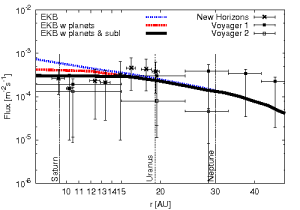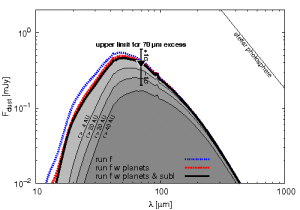An Improved Model of the Edgeworth-Kuiper Debris Disk
Simulated particle flux compared with in-situ measurements by New Horizons and Voyager 1 and 2. The solid black line takes into account planets and sublimation and represents our best fit to the data taken from Poppe et al. (2010), Han et al. (2011) and Gurnett et al. (1997).
Grafik: Poppe et al. 2010In contrast to all other debris disks, where the dust can be seen via an infrared excess over the stellar photosphere, the dust emission of the Edgeworth-Kuiper belt (EKB) eludes remote detection because of the strong foreground emission of the zodiacal cloud. We accessed the expected EKB dust disk properties by modeling. We treated the debiased population of the known trans-Neptunian objects (TNOs) as parent bodies and generated the dust with our collisional code. The resulting dust distributions were modified to take into account the influence of gravitational scattering and resonance trapping by planets on migrating dust grains as well as the effect of sublimation. A difficulty with the modeling is that the amount and distribution of dust are largely determined by sub-kilometer-sized bodies. These are directly unobservable, and their properties cannot be accessed by collisional modeling, because objects larger than (10...60) m in the present-day EKB are not in a collisional equilibrium. To place additional constraints, we used in-situ measurements of the New Horizons spacecraft within 20 au.
Spectral energy distribution of the EKB including planets and sublimation.
Grafik: Vitense et al. 2012We show that to sustain a dust disk consistent with these measurements, the TNO population has to have a break in the size distribution at s ≲ 70 km. However, even this still leaves us with several models that all correctly reproduce nearly constant dust impact rates in the region of giant planet orbits and do not violate the constraints from the non-detection of the EKB dust thermal emission by the COBE spacecraft. The modeled EKB dust disks, which conform to the observational constraints, can either be transport-dominated or intermediate between the transport-dominated and collision-dominated regime. The in-plane optical depth of such disks is τ∥(r > 10 au) ~ 10-6 and their fractional luminosity is fd ~ 10-7. Planets and sublimation are found to have little effect on dust impact fluxes and dust thermal emission. The spectral energy distribution of an EKB analog as seen from 10 pc distance peaks at wavelengths of (40...50) μm at F ≈ 0.5 mJy, which is less than 1% of the photospheric flux at those wavelengths. Therefore, EKB analogs cannot be detected with present-day instruments such as Herschel/PACS.
Read the full story in Vitense et al. 2012Externer Link

